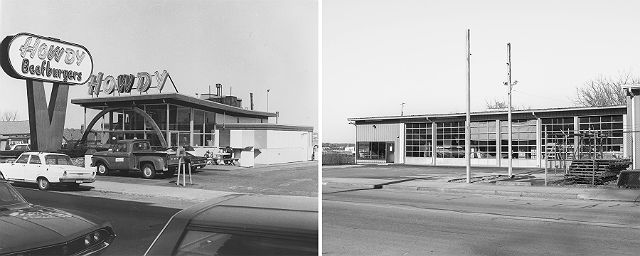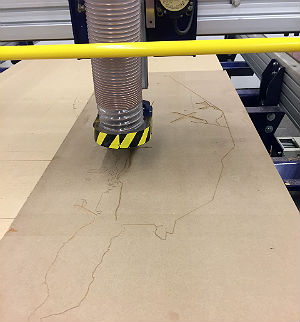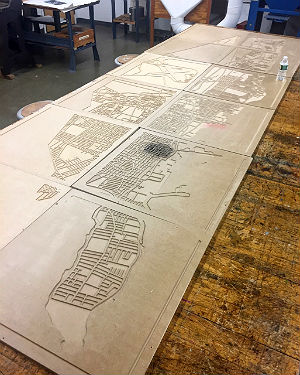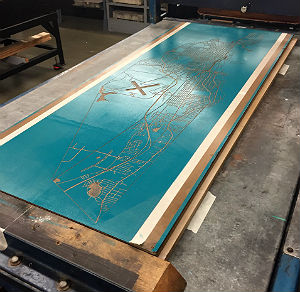Mapping New Bedford

Dean Haden, James McKeag and Zachary M. White at Groundwork! with one of the artist’s maps of New Bedford.
One of the great perks of being a member of Groundwork! is meeting new and interesting people all the time as they walk through the doors of 1213 Purchase Street. Some serious serendipity was happening when Zachary M. White came to Groundwork! one afternoon along with his unique maps of New Bedford. He had come to discuss exhibiting them both downtown at BCC with TDI Fellow James McKeag and also in the Groundwork! Gallery with founder Dena Haden.
A third venue for his cartography was quickly arranged after I saw Zach’s work. After all, I was in the planning stages of putting together the annual summer art show at Haskell Public Gardens called…Maps & Legends! Talk about a no-brainer!
I have to add a caveat to this story right here and now. I had actually already met Zachary here at Groundwork!, when he was part of the Spinner Publications crew on hand for the New Bedford Bookfest. He works for the publishing house – but even his colleagues there didn’t know that even as he was busy cataloging and digitizing so many of their beautiful historic photos, he was also busy in his spare time mapping the City of New Bedford – in sometimes surprising ways. Like enumerating every Dunkin’ Donuts in the city.
The archivist and artist may be a bit reticent regarding his work, but that’s okay. I’ve got a big mouth and a blog as well as an art show with which to make all the proper introductions between the public at large and this thoughtful artist’s work.
So, I put a few questions to Zach about how and why he began mapping New Bedford, and exactly what that process entails….
What drew you to map-making?
Senior year of undergrad I did my photo thesis project on Urban Renewal in New Bedford. It involved pairing photos from the 1960s and ‘70s with a photo of the same location now. I always referred to the project as being catalog photography rather than documentary because my goal was just to provide people with the visual information about places they have probably driven by hundreds of times. I intended to present the photographs with a current map overlaid with a map of how the streets appeared in the 1960s, plotting out where each photo is/was. I began tracing old maps and drawing new maps before running out of time, but I saved all the information for it hoping to one day finish it.

Historic photos of New Bedford Zach cataloged for his project: Howdy Burgers and a former Glaser Glass location.
Then when I started back at UMass for my Post-Bac, I was trying to think of some unifying idea or theme to work from. My work around this time was getting more abstract – but I wanted the abstract elements to be based on something real. So, I started incorporating pieces of cemetery maps that I have a lot of (not in a weird or dark way; my dad has been in the monument business for almost 40 years and from time to time you need a map to help you locate a particular section or grave). Finally, by last Fall, I found files I had worked on from the thesis project and decided to just make an actual map.
Do you begin with all hand drawings then graduate on to woodblock for the print-making?

The UMass CVPA router in action…
It depends on what my intentions are with the print, when I want to be able to replicate it or make an edition I like to plan out every layer and color prior to starting. To make the block for the full city map (on display at Haskell Public Gardens through August 17, 2017), I planned and drew it all out in Photoshop and double and triple checked every street to make my map to scale and be as accurate as possible. To maintain the accuracy of my maps, I had the block cut with a CNC router at UMass CVPA. The router uses the computer file of the image to cut it into a substrate which can then be inked up and printed. It’s during the actual printing process that I change things up. I might print something as intended a couple of times and then I just begin layering and changing colors and end up with 4 or 5 prints that are completely different even though they came from the same block.
How did you come upon the idea of mapping all the Dunkin’ Donuts in the city?

The plate ready for inking…
After making the full map, I wanted to be able to combine it with other elements and layers but I didn’t want to just draw random shapes or overlay different images so I tried to come up with how to create these elements that may appear random but are actually based on real information. During this time my advisor, Marc St. Pierre, and I talked about different ways of accomplishing that and where these elements could come from (like outlines of buildings on specific city blocks or tracing the patterns made by the crack sealer for streets) and this led to using the shapes made by things on a map. I started by coming up with places that there are a lot of in the city; banks, gas stations, fast food, etc. This lead to specific places/stores and Dunkin Donuts seemed like an obvious choice. I then used Google to find all the addresses of the Dunkin Donuts in the city (there were 18 at the time) and then plotted them to make a seemingly random shape I could use in my work.
What’s your favorite donut?
My favorite donut was always a vanilla frosted raised donut from Ma’s Donuts, but now that it’s gone…probably glazed.
Have you ever thought of turning your handiwork into an app?

Inked up and ready to print…
Actually, there is a project in the early stages that I’m working on at Spinner Publications with Al Saulniers (one of the authors of A Picture History of New Bedford Vols. 1 & 2) that’s similar in nature to my photo thesis that I hope make an app for. It wouldn’t involve any of the map prints I have done but, the plan is the app will show the locations of photographs plotted on a map while also being able to direct the user on a self-guided tour with captions and stories to go along with the photographs.
Thanks for your time, Zach. One last question: When can we expect a dive bar map?
If someone wants to compile a list, I’ll make the map!
- And, you can be sure we’ll share it with readers when Zach completes that project! In the meantime, you can catch his work on display now through Thursday, August 17 at Haskell Public Gardens as part of “Maps & Legends” and also find prints for sale in their gift shop. The park is open 7 days a week, dawn to dusk and the maps and sculpture of Kelly Zelen is on display in the greenhouses at 787 Shawmut Avenue. On Thursday, August 17th, Zach and Kelly will talk about their work during the community picnic fun-raiser at the park hosted by AHA! New Bedford, The Trustees and the Community Foundation. More info here.
- A Pride month to be proud of in New Bedford - May 30, 2019
- OUTTAKE: Inside the First Baptist Church renovation - May 2, 2019
- New Bedford Economic Development Council’s Spring Fling - April 30, 2019
